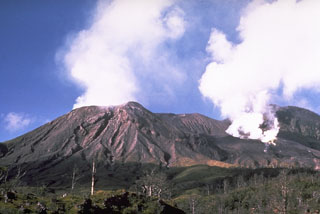Report on Langila (Papua New Guinea) — 14 June-20 June 2017
Smithsonian Institution / US Geological Survey
Weekly Volcanic Activity Report, 14 June-20 June 2017
Managing Editor: Sally Sennert.
Please cite this report as:
Global Volcanism Program, 2017. Report on Langila (Papua New Guinea) (Sennert, S, ed.). Weekly Volcanic Activity Report, 14 June-20 June 2017. Smithsonian Institution and US Geological Survey.
Langila
Papua New Guinea
5.525°S, 148.42°E; summit elev. 1330 m
All times are local (unless otherwise noted)
Based on analyses of satellite imagery and wind model data, the Darwin VAAC reported that on 14 June ash plumes from Langila rose 1.8 km (6,000 ft) a.s.l. and drifted WNW. On 20 June an ash plume drifted NW at an altitude of 2.1 (7,000 ft) a.s.l.
Geological Summary. Langila, one of the most active volcanoes of New Britain, consists of a group of four small overlapping composite basaltic-andesitic cones on the lower E flank of the extinct Talawe volcano in the Cape Gloucester area of NW New Britain. A rectangular, 2.5-km-long crater is breached widely to the SE; Langila was constructed NE of the breached crater of Talawe. An extensive lava field reaches the coast on the N and NE sides of Langila. Frequent mild-to-moderate explosive eruptions, sometimes accompanied by lava flows, have been recorded since the 19th century from three active craters at the summit. The youngest and smallest crater (no. 3 crater) was formed in 1960 and has a diameter of 150 m.

